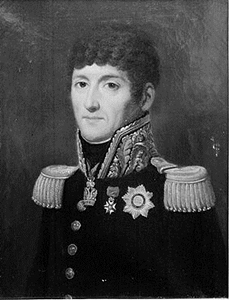General Jean-Barthélemot Sorbier

Born: November 17, 1762
Place of Birth: Paris, Paris, France
Died: July 23, 1827
Place of Death: Saint-Sulpice, France
Arc de Triomphe: SORBIER on the east pillar
Pronunciation:
The son of a surgeon and coming from a noble family, Jean-Barthélemot Sorbier entered the artillery in 1782. The next year he was commissioned as a lieutenant and joined the regiment of La Fére. After the arrival of the Revolution, in 1791 Sorbier was promoted to capitaine and then he began training the 7th Horse Artillery at Strasbourg. The following year Sorbier and his men served in the Army of the Center and then the Army of the Moselle when the Army of the Center was renamed. In June of 1793 he fought at Arlon where he distinguished himself and was wounded by a shot of grapeshot to the arm, and a few weeks later he received a promotion to chef d'escadron. However, three months later in September of 1793 Sorbier was suspended from the army due to his noble birth.
Sorbier returned to the army in April of 1795 when the Committee of Public Safety appointed him chef de brigade of the 3rd Horse Artillery. He and his men joined up with the Army of the Sambre and Meuse and then that September they took part in the crossing of the Rhine. Sorbier was next ordered to organize the camp cut off from Dusseldorf and then he was given command of the artillery of the left wing of the army. Sorbier went on to distinguish himself at Altenkirchen and Uckerath in 1796 and then in 1797 he distinguished himself at the Battle of Neuwied and received a promotion to général de brigade from General Hoche on the battlefield. Over the next few years he served in the Army of England, the Army of Mainz, and the Army of the Rhine. In January of 1800 Sorbier was promoted to général de division and appointed inspector general of artillery. That March he was placed in command of the artillery of the left wing of the army and then in July he took command of the artillery of the 2nd Army of the Reserve, later known as the Army of Grisons. In December Sorbier served at the crossing of the Splugen where he distinguished himself.
General Sorbier was named commander of the artillery of the camp of Bruges under General Davout in 1803. When war broke out in 1805, he became commander of the artillery of Davout's III Corps. Sorbier served throughout the campaign that year, eventually serving at the Battle of Austerlitz. The next year he was named commander-in-chief of the artillery of the Army of Italy where he would remain for a number of years. In 1808 Sorbier was named a Count of the Empire and then in 1809 he went on campaign again with the Army of Italy under Prince Eugene de Beauharnais. Sorbier served at the Battle of Raab in June and then after the conclusion of the campaign in 1809 he was awarded the Grand Cordon of the Iron Crown.
In 1811 Sorbier returned to France to take command of the artillery of the Imperial Guard. Taking part in the campaign against Russia of 1812, he commanded the artillery reserve of the Imperial Guard and served at Smolensk and Borodino. During the retreat, when Prince Eugene took command of the army, he named Sorbier artillery commander of the Grande Armée for the remainder of the retreat. When Napoleon rejoined the army in 1813, he kept Sorbier in this position and also named him inspector of artillery. Sorbier fought at Leipzig that October and then served in Champagne during the defense of France of 1814.
After Napoleon's abdication in 1814, the restored Bourbons named Sorbier a Commander of Saint Louis and awarded him the Grand Cordon of the Legion of Honor. During the Hundred Days of 1815 when Napoleon resumed power, Sorbier was elected a representative of Nièvre to the Chamber. After Napoleon's second abdication, Sorbier was put on non-activity, retired, and exiled to the town of Cognac for a few years.
Please see the Appendix about the name SORBIER on the Arc de Triomphe.
Bibliography
Updated March 2015
© Nathan D. Jensen